
Community Foundation for Southeast Michigan
Enjoying the Dequindre Cut Greenway in Detroit
Last week I had the pleasure of being in the presence of more than 300 Placemakers at the inaugural meeting of the Placemaking Leadership Council in Detroit. The goal of the Leadership Council, a new effort by the Project for Public Spaces (PPS) to consolidate and strengthen Placemaking as an international movement, is to build a culture of mutual support amongst the do-ers and deep thinkers at the forefront of the Placemaking movement, creating a community of practice around this important work. I was excited to attend, not least because of the energy and great ideas of everyone there. But, more selfishly, I’d also been nursing a conundrum for a while, and was glad to have a forum in which to hash it out.
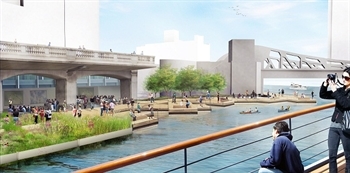
Recently released plans for the Chicago Riverwalk
Chicago Dept. of Transportation
Several months ago, the office of Mayor Emanuel announced plans to “complete the Chicago Riverwalk along the main branch of the Chicago River, which will build a continuous walkway and recreational amenity connecting the lakefront with the heart of downtown.” The Chicago Dept. of Transportation is seeking Transportation Infrastructure Finance Innovation Act (TIFIA) funds to help finance the build-out, and the design team includes the exceptionally thoughtful folks at Ross Barney Architects. The plan has all the markings of a great initiative to build on the city’s assets to create quality public places, and is one that the Metropolitan Planning Council fully supports. Soon after the announcement, though, I began to see letters to the editor criticizing this effort; not so much the project itself, but the choice to emphasize “icing on the cake” type efforts while a good chunk of the city is struggling. The argument went something like this: The South and West Sides of Chicago are experiencing record-high homicides. Schools are closing left and right. Demand for affordable housing is far outstripping supply. Why spend money on “optional” efforts like riverwalks in an already booming downtown district in the face of these basic needs?
So back at the Placemaking Leadership Council, this was the question I posed to everyone I talked to. It’s a great question in the context of Detroit, where PPS has worked closely with city leaders on the resurgence of Campus Martius Park, now a center of activity and programming that draws people year-round. My favorite Detroit story in light of my conundrum, though, is about a lower-profile, long-forgotten space called the Dequindre Cut. Formerly a below-street-level Grand Trunk railroad line, when service was discontinued in the ‘80s it became an overgrown refuge for the homeless. Over time, numerous graffiti masterpieces cropped up along the route. It might be located only half a mile from downtown, but its appearance warded people off.
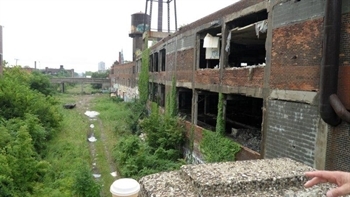
Dequindre Cut, pre-rehabilitation
Community Foundation for Southeast Michigan
When a group called the Community Foundation for Southeast Michigan (CFSEM) and community leaders came together to propose that a bike and pedestrian trail be constructed out of the Cut, they met widespread resistance – incredulity, really. Most responses could be summarized under the heading, “Detroit can’t pay its bills as it is. Are you crazy?” In a city with miles of existing infrastructure in various states of disrepair, unpaid bills and public service layoffs, the skepticism was certainly understandable. According to Tom Woiwode, Director of the GreenWays Initiative at CFSEM, other points of skepticism included:
• It’s too dangerous;
• It’s too short (the initial leg is 1.5 miles);
• It’ll cost too much, both to build and maintain;
• We’re a car city; nobody walks/bikes in this town;
• It doesn’t go anywhere; and
• We have much bigger problems.
(Note: As PPS points out, they always say it can’t be done.)
CFSEM and community leaders argued, though, that a public bike trail connecting popular destinations like the riverfront and Eastern Market, along with residential neighborhoods in between, was an essential part of the strategy to address the city’s problems, not a tangential one. They pushed back, point by point:
• It’s seen as dangerous because few people go there and no one maintains it, and this project will change that;
• The initial 1.5 miles is simply the starting point that could lead to much, much more;
• Few people walk or bike because Detroit has not effectively created space for walking and biking. This is a step to change that; and
• The initial leg may not go far, but it does connect important destinations.
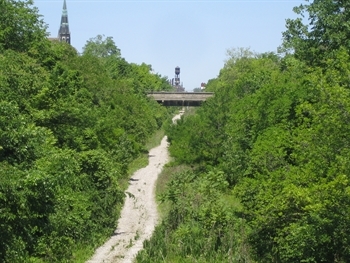
The newly acquired additional leg of the Dequindre Cut Greenway
Community Foundation for Southeast Michigan
The result of this effort by CFSEM and others? An urban recreational path, the Dequindre Cut Greenway, officially opened to the public in May 2009. Already, land has been acquired to build out another leg of the greenway, and plans are in the works to connect it to a trail in the Midtown neighborhood, further connecting residents to the destinations of Wayne State University and the Detroit Institute of Arts. The trail itself has become its own destination, in part because the elaborate graffiti murals on its abandoned bridges were preserved. They are such an attraction, in fact, that they have their own web site and book.
So, Detroit did have much bigger problems, as the final argument above notes. And it still does. Would Detroit have fewer problems right now had CFSM not spearheaded this public/private effort? I highly doubt it. They grew Detroit’s assets portfolio, rather than assuming that investment there meant weakening other efforts. As Peter Kageyama argues in his book For the Love of Cities, “In the city making ‘hierarchy of needs’ we see most communities focused on bottom-line, core issues of making cities functional and safe. There still are many communities that struggle to even deliver functional and safe but that is not the problem. The problem is when communities only focus on the functional and safe and never raise their aspirations.” He goes on to argue that part of the problem is certainly economic – it’s hard to aspire to higher levels when basic needs are not being met – and that of course communities must be functional and safe, but that is the minimum threshold. Ultimately, places that do not engage us emotionally do not feel worth caring about. To put it another way, consider Steven Farber’s “social interaction potential” metric, which, as recently noted in Atlantic Cities, attempts to quantify the relationship between the kinds of cities we build and the societies that we get out of them. Farber found that "If we build cities that isolate people, that don’t allow people to have social contact with one another, we’re at risk of people having lower levels of social capital, of people not being able to depend on their social networks for things.” If we want our cities to thrive, we need to be actively working to make them places that decrease isolation and increase social contact.
I agree with the riverwalk critics that a city cannot simply put its efforts into making thriving areas even better and brighter. The health of our cities and the quality of life of all of its residents depend on attention paid to every corner. If we can harness city leaders to raise money for Millennium Park or the Olympics, it is incumbent upon us to call upon the same leaders to, as Chicago is doing, raise millions for programs that serve at-risk youth across the city. That is urgent. But even if we had every young person across the city meaningfully engaged, and a quality school and affordable places to live in every neighborhood, that would be the baseline. It has to happen, but there is more. Of course cities have to meet critical, basic needs, but they also need to go beyond that to creating places that people care about, that make them proud to live there, and that they will fight to preserve. As Kageyama would say, no one ever raved about a restaurant because its silverware was clean.
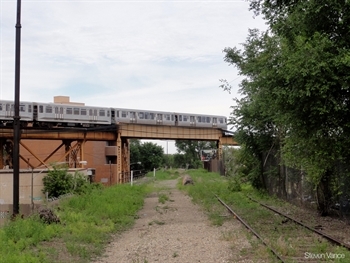
The Bloomingdale Trail
Steven Vance via Flickr
In the case of Chicago, that means creating meaningful places in which residents take pride in the 76 community areas outside of the Loop, as well as in. The under-construction Bloomingdale Trail, for instance, runs through the Northwest Side neighborhoods of Logan Square, Humboldt Park, Bucktown and Wicker Park – neighborhoods with a range of incomes and diversity of populations. On the Southwest Side, the Chicago Park District is working with a community group, the Little Village Environmental Justice Organization, to transform a former industrial site into a 24-acre park in Little Village, the community that contains the least green space per capita of any Chicago neighborhood. In the South Side neighborhood of Englewood, there are plans to convert two unused rail spurs — on 49th Street and between 58th and 59th Streets — into elevated bike trails.
Listening to the story of the Dequindre Cut in Detroit last week, I was reminded that the creation of these places – which are not in tourist destinations or downtown hot spots, but embedded in neighborhoods that so many Chicagoans call home – is not an add-on that cities undertake once they’ve solved all their other problems. Human beings, as David Julio Wang reminds us, are emotional creatures first. When we are surrounded by places that look and feel cared for, we ourselves feel cared for. Meeting the emotional component of people is far from icing on the cake; I’m starting to think it is the cake.
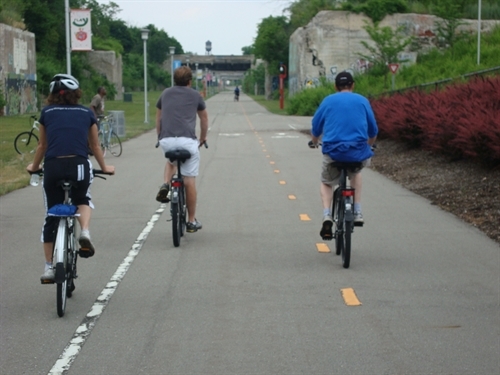
Community Foundation for Southeast Michigan